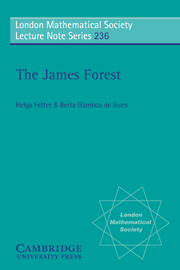Chapter 5 - Other pathological spaces
Published online by Cambridge University Press: 19 March 2010
Summary
Unmöglich ist's, drum eben glaubenswert
Johann Wolfgang von GoetheThis final chapter is devoted to a summary description of other noteworthy examples of pathological Banach spaces which are not directly related to the James spaces.
Undoubtedly, in the history of the geometry of Banach spaces a major role has been played by conjectures and questions about their properties, and the material in the previous chapter gives a good idea of the interplay between these conjectures and the appearance of many of today's well known spaces, which in turn gave rise to new questions and further conjectures …. Indeed, James* spaces J and JT are only two examples, albeit very important ones, of a vast class of spaces with unusual properties that have prompted the use of the adjective “pathological” when referring to them. Furthermore, the field is still very active, as testified by the recent constructions of Schlumprecht and of Gowers and Maurey. Thus it seems appropriate to conclude our exposition with a brief survey of some of these spaces, so that the readers get an idea of how things stand today.
Schreier's space S.
One of the earliest of these spaces with unusual properties was constructed in 1930 by Schreier [1], which provided a counterexample to the question of Banach and Saks whether each weakly convergent sequence in C[0, l] contains a subsequence whose arithmetic means converge in norm. In fact, what is nowadays called Schreier's space S is a slightly different version of Schreier's original construction which can be found for instance in Beauzamy and Lapresté [1] and Casazza and Shura [1].
- Type
- Chapter
- Information
- The James Forest , pp. 231 - 236Publisher: Cambridge University PressPrint publication year: 1997



